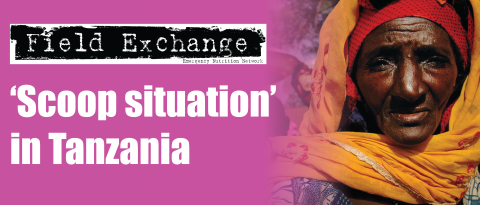Triggers, Early Warning and Response in FFP Assistance
Summary of research1

Villagers in Mali appraising Months of Adequate Household Food Provisioning (MAHFP).
The Office of Food for Peace (FFP) FY 2008 Title II Assistance Proposal Guidelines (APGs) include the incorporation of 'early warning and response mechanisms (including trigger indicators)' into Title II-supported multi-year assistance programmes (MYAPs). Prior to 2006, in order to respond to an increase in food needs due to a shock, resources were often diverted from the development programme to the emergency response. While this approach did facilitate a rapid response to acute food needs, it ran the risk of potentially undermining advances being achieved by the development interventions. The FY 2008 Title II APGs aim to improve this approach by allowing the continuation of development interventions, with appropriate modifications to respond to changing circumstances, while adding emergency resources to the programme to respond to food needs over and above those that are being addressed by the adjusted development interventions.
A recent paper set out to review briefly cooperating sponsor experiences with operationalising trigger indicators2 and early warning and response systems to date, outline the key characteristics of early warning and response systems and trigger indicators within the MYAP context, and provide suggestions on how cooperating sponsors can operationalise the FFP guidance on trigger indicators. Cooperating sponsor experiences reviewed within a MYAP context were Africare, CARE, Catholic Relief Services, Food for the Hungry and World Vision. The main findings of this review include the following:
Trigger indicators differ from other monitoring and evaluation requirements for Title II MYAPs in several important ways. First, trigger indicators are strongly encouraged, but not mandatory for cooperating sponsors to include in MYAP proposals. Second, trigger indicators aim to enhance programme flexibility rather than monitor or evaluate programme impact, unlike most other reporting requirements. Third, trigger indicators are not standardised by FFP - the cooperating sponsor s have a great deal of flexibility to define trigger indicators. Finally, trigger indicator information is to be reported to FFP principally via ongoing dialogue with Missions, rather than via existing annual reporting requirements.
Many cooperating sponsor programmes will be developing trigger indicators in the absence of full food security early warning systems in their programme area. Cooperating sponsors should remember that the purpose of the trigger indicators is to identify when a shock may undermine food security sufficiently to warrant either adjustments in programming of Title 11 resources or additional emergency food resources.
Cooperating Sponsors that aim to operationalise the FFP guidance on trigger indicators should consider the following:
- Trigger indicators should be selected to provide advance notice (typically one to six months) of a potentially serious deterioration in food security conditions. To identify trigger indicators, it is necessary to first identify the shocks of greatest local concern - including slow-onset sub-national/local shocks. A brief justification for the trigger indicators in a proposal should draw from the national vulnerability analysis that the cooperating sponsor conducted as a basis for the proposal.
- Given the function of trigger indicators, the thresholds of trigger indicators should be set conservatively.
- Trigger indicator monitoring plans can encompass data collection from primary and secondary sources, and should identify triangulation/validation strategies when data indicate that trigger indicator thresholds have been reached. Trigger indicator levels at the start of the programme should be documented, and triangulation/validation strategies for trigger indicator data identified.
- Trigger indicators should be linked to a series of actions, with an emphasis on partnering with national and community food security, early warning and/or disaster preparedness institutions wherever possible.
- Trigger indicator monitoring and analysis should be integrated into ongoing monitoring and evaluation of the cooperating sponsor, rather than carried out as a discrete and parallel activity.
Recommendations to operationalise guidelines on trigger indicators
- FFP strongly encourages cooperating sponsors to include trigger indicators in the MYAP proposals, and where they are not included, the proposal should explain why these mechanisms are not necessary. Where cooperating sponsors decide to include trigger indicators in their MYAP proposals, the following guidance is given. The proposal should identify the shocks of greatest concern to food insecurity in the population concerned. Nutritional and dietary impact indicators are not in themselves sufficient as trigger indicators in a MYAP proposal. Cooperating sponsors that do not have a well-established early warning presence in a given country should start by taking stock of what is already being done in the country in early warning.
- The proposal should indicate the trigger thresholds or indicate how and when they will be established. The thresholds should be justified briefly, unless they are to be determined via the baseline or other research at the start up of the MYAP.
- The MYAP proposal should identify the strategies to be used to obtain the primary and/or secondary trigger indicator data. Proposals should describe how the trigger indicator information would be integrated into the agency's broader monitoring and evaluation.
- The proposal should briefly note plans for keeping the Mission and FFP up to date, including where evidence of a problem is seen, information on which populations may be affected and why, the potential severity and assumptions underlying the scenario.
- The proposal should briefly present a plan for how the cooperating sponsor will engage with national or sub-national early warning and disaster preparedness and response institutions and networks, at least at the level of information sharing.
- Cooperating sponsors should include plans for at least one situational and needs assessment to follow up where trigger indicator thresholds are reaching.
1Mathys, E (2007). Trigger Indicators and Early Warning and Response Systems in Multi-Year Title II Assistance Programs. Washington, DC: Food and Nutrition Technical Assistance Project, Academy for Educational Development, 2007.
2Indicator used to determine the threshold at which MYAPs need to shift activities and/or require additional resources for new activities in response to a slow-onset shock.
Imported from FEX website


